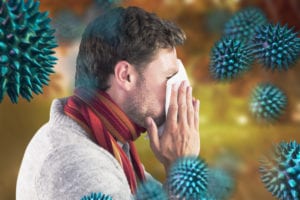Written by Joyce Smith, BS. Lavender aromatherapy significantly improved quality of life, sleep quality, and fatigue levels among the twenty-seven participating subjects with perennial allergic rhinitis.
 Perennial allergic rhinitis (PAR) is a season-independent chronic disorder affecting approximately 500 million people. It occurs following exposure to allergens that lead to symptoms including sneezing, rhinorrhea, and nasal obstruction 1. As one of the most frequent chronic diseases, it can manifest as chronic fatigue due to lack of sleep, cognitive dysfunction, depression, reduced workplace productivity and impaired quality of life2,3.
Perennial allergic rhinitis (PAR) is a season-independent chronic disorder affecting approximately 500 million people. It occurs following exposure to allergens that lead to symptoms including sneezing, rhinorrhea, and nasal obstruction 1. As one of the most frequent chronic diseases, it can manifest as chronic fatigue due to lack of sleep, cognitive dysfunction, depression, reduced workplace productivity and impaired quality of life2,3.
Pharmacological drugs including antihistamines and topical steroids may cause extreme drowsiness and even growth problems for children 4 , therefore encouraging a necessary treatment shift to complementary and alternative medicines (CAM). Aromatherapy, particularly direct inhalation of aroma essential oil fragrance, has long been used for various inflammatory diseases 5. For example, essential oils such as eucalyptus, ravensara, and frankincense have shown anti-inflammatory and immune modulating capabilities 6 while sandalwood, frequently used for relaxation or sedation, provides potential benefits for hypersensitive individuals 7.
The objective of this randomized controlled trial 8 was to investigate the effects of aromatherapy oil inhalation on symptoms, quality of life, sleep quality, and fatigue level among adults with perennial allergic rhinitis (PAR). Fifty-four men and women, aged 20 to 60 years, were randomized to inhale a blend of Santalum album (sandalwood), Ravensara aromatica (ravensara), and Boswellia carterii (frankincense) essential oils or almond oil (the placebo) 5 minutes twice daily for 7 days. Completion of aromatherapy revealed the following results:
- There was a greater significant reduction in Total Nasal Symptom Score in the aromatherapy group than in the almond oil group (P=0.022). Both groups improved significantly in “nose obstruction” (P=0.035) while “sneeze”, “runny nose”, and “itchy nose” demonstrated a higher improvement in the aromatherapy group.
- The aromatherapy group also showed significantly higher improvements in “quality of life” score (P=0.002) and “sleep quality and fatigue: (P=0.021)
In conclusion, this randomized controlled trial showed that the inhalation of blended oil from ravensara, frankincense, and sandalwood alleviated subjective symptoms, improved the disease-specific quality of life, reduced fatigue, and improved sleep quality among adult patients with PAR.
These findings indicate that aromatherapy oil inhalation can be used as a safe and effective complementary intervention to reduce PAR symptoms and improve quality of life in afflicted individuals.
Source: Choi, Seo Yeon, and Kyungsook Park. “Effect of inhalation of aromatherapy oil on patients with perennial allergic rhinitis: a randomized controlled trial.” Evidence-Based Complementary and Alternative Medicine 2016 (2016).
Copyright © 2016 S. Y. Choi and K. Park. This is an open access article distributed under the Creative Commons Attribution License, which permits unrestricted use, distribution, and reproduction in any medium, provided the original work is properly cited.
Click here to read the full text study.
Posted October 31, 2017.
Joyce Smith, BS, is a degreed laboratory technologist. She received her bachelor of arts with a major in Chemistry and a minor in Biology from the University of Saskatchewan and her internship through the University of Saskatchewan College of Medicine and the Royal University Hospital in Saskatoon, Saskatchewan.
References:
- Bousquet J, Khaltaev N, Cruz AA, et al. Allergic rhinitis and its impact on asthma (ARIA) 2008. Allergy. 2008;63(s86):8-160.
- Stuck BA, Czajkowski J, Hagner A-E, et al. Changes in daytime sleepiness, quality of life, and objective sleep patterns in seasonal allergic rhinitis: a controlled clinical trial. Journal of allergy and clinical immunology. 2004;113(4):663-668.
- Lamb CE, Ratner PH, Johnson CE, et al. Economic impact of workplace productivity losses due to allergic rhinitis compared with select medical conditions in the United States from an employer perspective. Current medical research and opinion. 2006;22(6):1203-1210.
- Kelly HW, Sternberg AL, Lescher R, et al. Effect of inhaled glucocorticoids in childhood on adult height. New England Journal of Medicine. 2012;367(10):904-912.
- Serafino A, Vallebona PS, Andreola F, et al. Stimulatory effect of Eucalyptus essential oil on innate cell-mediated immune response. Bmc Immunology. 2008;9(1):17.
- Ferrara L, Naviglio D, Armone Caruso A. Cytological aspects on the effects of a nasal spray consisting of standardized extract of citrus lemon and essential oils in allergic rhinopathy. ISRN pharmaceutics. 2012;2012.
- Okugawa H, Ueda R, Matsumoto K, Kawanishi K, Kato A. Effect of α-santalol and β-santalol from sandalwood on the central nervous system in mice. Phytomedicine. 1995;2(2):119-126.
- Choi SY, Park K. Effect of inhalation of aromatherapy oil on patients with perennial allergic rhinitis: a randomized controlled trial. Evidence-Based Complementary and Alternative Medicine. 2016;2016.
